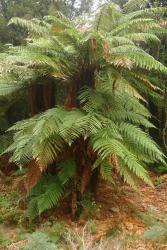Terrestrial ferns. Rhizomes long-creeping, decumbent, or erect and forming an arborescent trunk covered in adventitious roots and persistent stipe bases, bearing multicellular hairs. Fronds monomorphic or dimorphic, not articulated to rhizome. Laminae 2-pinnate (not NZ) or 3–4-pinnate (NZ), usually catadromous, coriaceous, bearing multicellular hairs. Veins free. Sori round, borne on abaxial surface away from margins (not NZ), or ovate to round, borne on vein endings of the abaxial surface, at or near the margins of the lamina (NZ); paraphyses present; sori exindusiate (not NZ) or protected by a membranous inner indusium and a reflexed lamina lobe, together forming a bivalvate or cup-like structure (NZ); receptacles slightly elevated, sporangia maturing in gradate sequence. Sporangia with slightly oblique annulus, usually 64 spores per sporangium. Homosporous; spores trilete, granulate or with reticulate lobes surrounding depressed areolae (NZ), or with tuberculae fused into irregular ridges (not NZ), or with a prominent flange separating a tuberculate proximal face and perforate distal face (not NZ), lacking chlorophyll.
A family of three genera and about 30 species. The family, as construed by Smith et al. (2006), comprises three genera – Dicksonia, Calochlaena and Lophosoria. The latter genus is confined to Central and South America and differs from the other two genera in having exindusiate sori on the abaxial surface of the laminae. It has often been included in its own family (e.g. Kramer 1990). However, in a phylogenetic analysis of tree ferns based on four protein-coding plastid loci, Korall et al. (2006) demonstrated that these three genera formed a well-supported clade, sister to Metaxyaceae, and with some affinity to Cibotiaceae. They also showed that the family Dicksoniaceae, as understood by Kramer (1990) to include also Thyrsopteris, Culcita, Cibotium and Cystodium, was polyphyletic. These genera are now all included in different families (Smith et al. 2006).
The family is represented in New Zealand by a single genus, Dicksonia, although Calochlaena is found in Australia and the Pacific.
The family name Dicksoniaceae M.R.Schomb. is conserved against Thyrsopteridaceae C.Presl.
The Dicksoniaceae comprises terrestrial ferns that have arborescent trunks, or sometimes creeping or decumbent rhizomes, with large 2–4-pinnate fronds bearing hairs, sori that are usually marginal and protected by bivalvate indusia made up of an inner membranous indusium and an outer reflexed lamina flap, sporangia with an oblique annulus, and trilete spores.
Occurs in Central and South America, south-east Asia, Australasia and the Pacific. One genus and three endemic species in New Zealand.
| Category | Number |
|---|---|
| Indigenous (Endemic) | 3 |
| Total | 3 |




